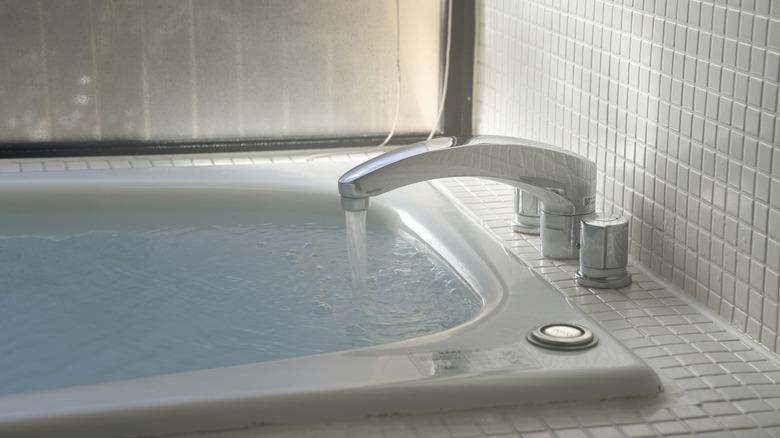Prepping For A Power Outage? Here's Why You Should Fill Up Your Bathtub
We may receive a commission on purchases made from links.
Extreme weather, from tornadoes to hurricanes to flooding, can knock the power out for extended periods of time. Because it can happen at any time, you should have a weather plan in place and be prepared. Start by thinking through your basic necessities: food, safety, water, shelter. It may be helpful to develop a checklist to have on hand to prepare your home for emergencies. The American Red Cross recommends gathering enough food, lighting sources, medicine, drinking water to last two weeks, first aid supplies, and a battery-powered weather radio (like this one on Amazon, which has a hand crank and solar charging capability). Prepare the exterior of your home by bringing inside or securing outdoor furniture and décor that may be blown around. Nationwide Insurance recommends trimming nearby trees, repairing flood-prone areas, and repairing any damaged shingles. Another thing you should do is fill your bathtub with water.
You may not think about filling your bathtub with water, but you absolutely should. The water in your bathtub will come in handy if one of many emergency scenarios occurs: A busted water pipe, damage to the city's water supply, or loss of power at water treatment facilities, impairing their ability to ensure water safety. Flooding can also cause wells to be contaminated. The average bathtub can hold about 40 gallons of water (or up to 200 gallons for some luxury tubs), according to Home Depot. If you happen to be remodeling, consider water storage when choosing the right type of bathtub. During storm prep, take a moment to clean your bathtub well before filling it.
Purify the water if it's needed for drinking
If the emergency situation lasts several days and your freshwater supply is exhausted, the extra water can be purified into drinking water. According to the U.S. Centers for Disease Control and Prevention (CDC), you should store at least one gallon of drinking water per person per day for at least three days. If you have used up your supply of fresh water, there are a few ways to purify the bathtub water. The best method is to boil it. The U.S. Environmental Protection Agency (EPA) recommends boiling water for at least 1 minute to kill bacteria and viruses to make water safe to drink during an emergency.
If the power is out, though, boiling water may be difficult to do. In that case, you can add eight drops of 6% liquid chlorine bleach to one gallon of water, or six drops of 8.25% liquid chlorine bleach and let it sit 30 minutes to disinfect, according to the EPA. If you don't have bleach, five drops of 2% tincture of iodine per quart of water will also work. If you want to avoid having to do any of that, you can purchase emergency water storage bags before a storm, place it in your bathtub, and fill it for extra water storage. They're BPA-free, hold 65 gallons of water, and are safe for drinking right out of the bag. These bags retail for about $32 on Amazon at the time of this writing.
Other uses for stored water
Another purpose for storing water in your tub is flushing a toilet, which is absolutely necessary even when the power is out. Flush a toilet without running water by using a bucket to fill the tank with water from the bathtub. Or pour the water directly into the bowl to flush. Plumbing Company Pros advises doing this: Pour the water into the bowl with enough force to mimic a flush. It should drain as if you flushed with the handle. The toilet can be flushed without electricity, but it does need water.
The bathtub water will also be useful for washing your hands and dishes. Make sure the drain plug is firmly placed in the drain and fill the sink using your bucket, and wash as normal. HomeFixMagic blog offers more uses for the bathtub water. In the event of a cut or medical emergency, the water can be used to clean a wound or medical devices. Likewise, if a small fire breaks out, you'll have a resource to fight it. Once electricity is restored, be sure to check your city's guidance on water usage. If you're on a well, you may need to reset or restart your water well after a power failure. Water is a precious resource we can take for granted when it's plentiful. But in an emergency, if water becomes scarce, your bathtub can be one of your greatest resources.


